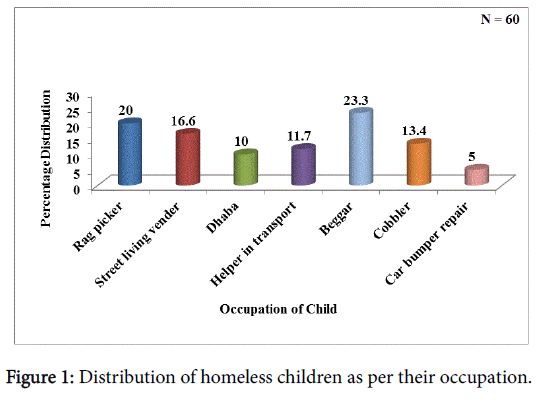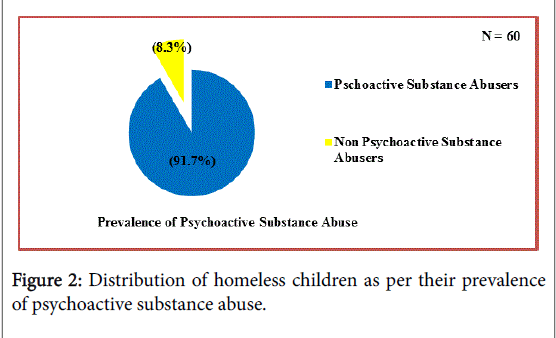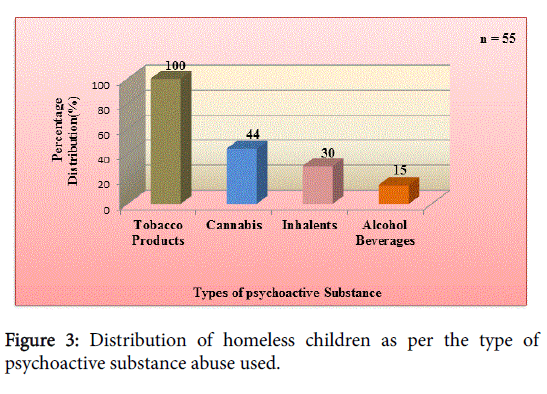Research Article Open Access
Study on Prevalence and It's Contributing Factors of Psychoactive Substance Abuse among Homeless Children
Manjinder Singh1*, Kanika Thapar1, Jasbir Kaur1, Pankaj Kumar1 and Prabhjot Saini21Department of Psychiatry, DMCH College of Nursing, DMC and Hospital, Ludhiana, India
2Department of Med-Surg Nursing, DMCH College of Nursing, DMC and Hospital, Ludhiana, India
- *Corresponding Author:
- Manjinder Singh
Student, DMCH College of Nursing
DMC and Hospital, Ludhiana, India
Tel: +919888050856
E-mail: manjinderlehra@gmail.com
Received date: January 30, 2017; Accepted date: July 07, 2017; Published date: July 14, 2017
Citation: Singh M, Thapar K, Kaur J, Kumar P, Saini P (2017) Study on Prevalence and It’s Contributing Factors of Psychoactive Substance Abuse among Homeless Children. J Addict Res Ther 8:333. doi:10.4172/2155-6105.1000333
Copyright: © 2017 Singh M, et al. This is an open-access article distributed under the terms of the Creative Commons Attribution License, which permits unrestricted use, distribution, and reproduction in any medium, provided the original author and source are credited
Visit for more related articles at Journal of Addiction Research & Therapy
Abstract
Homeless children are those who live alone on the street. UNICEF estimated that India has 18 million homeless children which is the largest population in the world. Use of psychoactive substance is particularly high in street children as seen in 40-70% of street children across various Indian cities are substance abusers. The study was conducted at District Ludhiana, Punjab. 60 Homeless children of age group 6-18 years were selected by snowball sampling. WHO Assist V 3.0 and a structured questionnaire were used to collect data. Findings reveals that 55 (91.7%) of the homeless children were psychoactive substance abusers with 14.95 ± 02.50 years as mean age of initiation of the substance abuse. Major factors to initiate substance abuse were enjoyment and peer pressure. Age (p=0.02), Male gender (p=0.43), Illiteracy (p=43) were associated with substance abuse among homeless children.
Keywords
Factors; Homeless children; Prevalence; Substance abuse
Introduction
Homeless children are those who live alone on the street. Homeless working children are those who work on the streets for their lively hood and return to their parents in the night. The categories of the children are called the children of homeless families who have no home, so they live with their families on the street [1].
UNICEF, describes street children in the following manner: The term denotes not only a place of congregation, but also a certain set of working and living conditions. The vast majorities are on the street to make a living for their families and/or themselves. For these children, the street is, above all, a work place. Second, they spend large amounts of time on the street frequently because of the low returns on their labour. Third, most make their way into the informal sector as petty hawkers, shoe-shine boys, scavengers of raw materials or even thieves and street prostitutes. Fourth, by the nature of their work and life, they are normally on their own, largely unprotected by adults. For these reasons above all others, they are vulnerable to many dangers and abuses and mostly to the psychoactive substance abuse [2].
Many studies reveal that, substance abuse is also significantly associated with domestic violence, maltreatment of the child, nuclear families, runaway status and working status of the child [3].
Children live and work on the street because their parents are poor, they are orphans, or they have run away from home, often to escape abuse. They are invariably malnourished, receive scant education and medical treatment, they face difficulties in providing themselves with good sources of food, clean drinking water, health care services, toilets and bath facilities and adequate shelter. They also suffer from absence of parental protection and security; there is a lack of any kind of moral and emotional support [4].
The researcher has also observed that many young homeless children use cigarette smoking and tobacco in the chewing form and much other type of psychoactive substances in Ludhiana city. Moreover, Most of them are unaware of the ill-effects or the long term consequences of use of these substances.
So this study is aimed to assess the prevalence and to find out the contributing factors of psychoactive substance abuse and to educate the homeless children about the ill-effects of psychoactive substance abuse.
Materials and Methods
The study was conducted at various selected areas of Ludhiana, Punjab with objectives to assess the prevalence and its contributing factors of psychoactive substance abuse among homeless children.
The descriptive (exploratory) design was used and 60 homeless children of age group 6-18 years were selected by snowball sampling technique. The tool used for study consists of 3 parts. Part A socio demographic profile was prepared by author; Part B WHO Assist V 3.0 was used to assess the prevalence and Part C Structured Questionnaire to assess the contributing factors of psychoactive substance abuse. The questionnaire has 25 different types of contributing factors for the initiation of psychoactive substance abuse among homeless children. Socio demographic profile and structured questionnaire were found to be valid by different experts and WHO Assist V 3.0 was a standardized tool. The reliability of WHO Assist V 3.0 is pre-determined by Chronbach’s alpha and was found to be 0.80 and the reliability of structured questionnaire to assess the contributing factors of psychoactive substance abuse was determined by split half method and was found to be 0.86. Data was collected in the month of January, 2016 by investigator through self-report using interview schedule. Written informed assent was taken from subjects. The study was approved by research and ethical committee of DMC and Hospital, Ludhiana. The subjects were explained about the objectives and activities of research projects were given to them and they were assured that their responses would be kept confidential by providing information sheets. Collected data were analyzed by using SPSS version 16. Descriptive statistics such frequency, mean, standard deviation were used to analyzed the socio demographic variables. Chi square was used to find out association of prevalence of psychoactive substance abuse among homeless children with their selected socio demographic variables.
Table 1 depicts the socio-demographic characteristics of homeless children. Out of 60 subjects less than half, i.e., 28 (46.6%) were in the age group of 13 to 15 years. Maximum of the homeless children, i.e., 54 (90%) were males and 50 (83.4%) belonged to Hindu religion. Most of the homeless children, i.e., 40 (66.7%) were illiterates. Majority of the homeless children, i.e., 50 (83.4%) were living with their family on street for more than 5 years.
| Socio Demographics variables | f (%) |
|---|---|
| Age(in years) | |
| 10-12 | 06 (10.0) |
| 13-15 | 28 (46.6) |
| 16-18 | 26 (43.4) |
| Gender | |
| Male | 54 (90.0) |
| Female | |
| Religion | |
| Hindu | 50 (83.4) |
| Muslim | 10 (16.6) |
| Level of education | |
| Illiterate | 40 (66.7) |
| Primary | 10 (16.7) |
| Elementary | 07 (11.6) |
| Higher secondary | 03 (05.0) |
| Habitat | |
| Alone at street | 03 (05.0) |
| With family at street | 50 (83.4) |
| With friends at street | 03 (05.0) |
| With relatives at street | 04 (06.6) |
| Years living on the street (in years) | |
| <1 | 02 (03.4) |
| 1-2 | 01 (01.6) |
| 3-5 | 07 (11.6) |
| >5 | 50 (83.4) |
| *(Mean age of homeless children=13.95 ± 01.52) | |
Table 1: Distribution of homeless children as per socio demographic variables.
Figure 1 depicts the occupation of children nearly one fourth of the homeless children, i.e., 14 (23.3%) were Beggar followed by 12 (20%) who were rag pickers, 10 (16.6%) were street living venders, 08 (13.3%) were cobblers, 07 (11.7%) were working as a helper in transport, 06 (10%) were working on dhaba and rest 03 (05%) were working as a car bumper repair worker.
Figure 2 indicate the prevalence of psychoactive substance abuse among homeless children. Out of 60 maximum of the homeless children, i.e., 55 (91.7%) were psychoactive substance abusers and only 05 (08.3%) were non psychoactive substance abusers.
Figure 3 illustrate the different types of psychoactive substances used by the homeless children. All the subjects, i.e., 55 (100%) reported that they were using tobacco products, 26 (44%) were cannabis abusers followed by 18 (30%) who were using inhalants and 09 (15%) were alcoholic.
Table 2 indicates the age of initiation of psychoactive substance abuse among homeless children. Out of 55, 22 (40%) children initiated psychoactive substances in the age group of 11-14 years followed by 18 (33%) children who started using psychoactive substances in the age group 15-18 years and more than one fourth of the subjects, i.e., 15 (27%) initiated in the age of 07-10 years.
| Age of initiation of psychoactive Substance Abuse (in years) | f (%) |
|---|---|
| 07-10 | 15 (27.27) |
| 11-14 | 22 (40.00) |
| 15-18 | 18 (32.73) |
Table 2: Distribution of homeless children as per their age of initiation of psychoactive substance abuse.
Table 3 indicates the contributing factors for initiation of psychoactive substance abuse among homeless children. Majority of the homeless children, i.e., 51 (92.7%) started taking psychoactive substances for enjoyment purpose followed by 49 (89.09%) who took psychoactive substances due to experienced peer pressure, 29 (52.72%) initiated psychoactive substances by imitating any family member, relative, stranger, role model etc., 08 (14.54%) took psychoactive substances due to easy availability of the substance and only 01 (1.81%) subject reported that he started psychoactive substance because he/she did not get any family support.
| Contributing factors* | f (%) |
|---|---|
| Enjoyment | 51 (92.70) |
| Experienced peer pressure | 49 (89.09) |
| Imitating any family member, relative, stranger, role model, etc. | 29 (52.72) |
| Substance Easily Available | 08 (14.54) |
| Not getting family support | 01 (01.81) |
Table 3: Distribution of contributing factors for initiating of psychoactive substance abuse, *subjects had multiple responses.
Table 4 depicts the association of prevalence of psychoactive substance abuse among homeless children with their selected socio demographic variables. It represents that children in age group 13-15 years were more prevalent for psychoactive substance abuse followed by children in age group 16-18 years and 10-12 years respectively. These results were also found to be statistically significant at P=0.02*. As per gender, males were more prevalent for psychoactive substance abuse than females. As per level of education, illiterates children were more prevalent for psychoactive substance abuse followed by children who were educated up to primary, elementary and higher secondary level.
| Socio Demographics variables | Use of psychoactive substance | n | χ2 Value | p value | |
|---|---|---|---|---|---|
| Yes (n=55) | No (n=05) | ||||
| Age (in years) | |||||
| 4 | 2 | 6 | χ2=7.48 | p=(0.02)* | |
| 13-15 | 25 | 3 | 28 | df=2 | |
| 16-18 | 26 | 0 | 26 | ||
| Gender | |||||
| Male | 49 | 5 | 54 | χ2=0.606 | p=(0.43) NS |
| Female | 6 | 0 | 6 | df=1 | |
| Level of education | |||||
| Illiterate | 37 | 3 | 40 | p=(0.43) NS | |
| Primary | 8 | 2 | 10 | χ2=2.72 | |
| Elementary | 7 | 0 | 7 | df=3 | |
| Higher secondary | 3 | 0 | 3 | ||
Table 4: Association of prevalence of psychoactive substance abuse among homeless children with their selected socio-demographic variables,
*=Significant at p = 0.05; NS=Not Significant at P>0.05.
Discussion
The analysis of socio demographic profile of homeless children revealed that less than half, i.e., 28 (46.6%) belonged to age group of 13 to 15 years, maximum of them 54 (90%) were males. Most of them, i.e., 40 (66.7%) were illiterates and 50 (83.4%) homeless children were living with their family on street. Majority of them, i.e., 50 (83.4%) were living on street for more than 5 years. Nearly one fourth of the homeless children, i.e.,14 (23.3%) were Beggars. Almost similar findings were reported by Islam et al. [5], they conducted a crosssectional study among 215 street children in Guwahati city Assam and the findings of study show that majority of the study participants were in the age group of 10-15 years, maximum numbers of respondents were male, i.e., 90.7% [5]. Similar findings were reported by Ray et al. [6] conducted a study with NDDTC at Delhi and Bangalore to assess the prevalence of inhalants among homeless children and the findings of study show that the total sample majority (71%) were illiterate [6]. Analysis revealed that the prevalence of psychoactive substance abuse among homeless children was 91.7 % and from these psychoactive substance abusers 100% reported that they were using tobacco product and age of initiation of psychoactive substance abuse in the age group of 11-14 years. Similar findings were reported by Benegal and Kulbhusan [7] conducted a survey project in collaboration between NIMHANS, Bangalore and the Bangalore forum for street and working children and findings of study shows that the common substance used by street children was tobacco, i.e., 76% [7]. Almost Similar findings were reported by Praneeth et al. [8] conducted a prospective study on prevalence and pattern of substance abuse among street children in Andhra Pradesh and the findings of study shows that sample initiated abuse of substance at age group of 12-14 years [8]. The present study indicated that the most common contributing factor for initiation of psychoactive substance abuse was enjoyment which was reported in 51 (92.7%) homeless children. The second most common contributing factor for initiation of psychoactive substance abuse was experienced peer pressure which was reported in 49 (89.09%) homeless children. Similar finding were reported by Praneeth et al conducted a prospective study on prevalence and pattern of substance abuse among street children and the findings of study show that initiation of substance abuse by majority of the children, i.e., 52.10% was influenced by their friends/peer pressure followed by for enjoyment purpose, i.e., 50.50% [8]. Present study found that there was significant association of prevalence of psychoactive substance abuse among homeless children with the age of children. Illiterate children were having high prevalence of psychoactive substance abuse. Almost similar findings were reported by Islam et al. conducted a cross-sectional study among 215 street children in Guwahati City Assam and the findings of study show that As the age increases substance use was more common as compared to younger group the risk of substance abuse was high in those who had never been to school/Illiterate [5].
Conclusion
The present study was conducted among 60 homeless children in the age-group of 6 to 18 years in district Ludhiana and it was concluded that maximum of the homeless children were psychoactive substance abusers in which majority were males, belonged to Hindu religion and illiterates. Enjoyment and experience peer pressure were two common contributing factors for psychoactive substance abuse. IEC material was also provided to enlighten the ill effects of tobacco so that it can enhance the level of motivation to quit among tobacco users.
References
- Embleton L (2013) The epidemiology of substance use among street children in resource-constrained settings: A systematic review and meta-analysis. Addiction 108: 10-20.
- Child protection and Child Rights (2015) Vulnerable children, children issues, street children.
- Sharma N, Joshi S (2013) Preventing substance abuse among street children in India: A literature review. Health Sci J 7: 137-48.
- Singh A, Purohit B (2011) Street children as a public health fiasco. Peace Rev 23: 102-109.
- Islam F, Kar S, Debroy A, Sarma R (2008) Substance abuse amongst the street children in Guwahati city, Assam. Ann Med Health Sci Res 4: 215-220.
- Ray R, Dhawan A, Ambekar A, Yadav D, Chopra A (2011) Co-ordination and convergence of Delhi district health services programmes and drug use intervention for the out of school child 2010-2011. National drug dependence treatment centre, All India Institute of Medical Sciences. Under Government of India & World Health Organization Collaborative Program (Biennium 2010-2011).
- Benegal V, Kulbhusan (1998) Drug abuse among street children in Bangalore. A project in Collaboration between NIMHANS, Bangalore and the Bangalore Forum for street and working children, Monograph funded by CRY, pp: 1-19.
- Praneeth RA, Dhannaram PK, Akondi BR (2014) A study on prevalence and pattern of substance abuse among street children and adolescents in the state of Andhra Pradesh, India. Indian Journal of Fundamental and Applied Life Sciences 4: 1-14.
Relevant Topics
- Addiction Recovery
- Alcohol Addiction Treatment
- Alcohol Rehabilitation
- Amphetamine Addiction
- Amphetamine-Related Disorders
- Cocaine Addiction
- Cocaine-Related Disorders
- Computer Addiction Research
- Drug Addiction Treatment
- Drug Rehabilitation
- Facts About Alcoholism
- Food Addiction Research
- Heroin Addiction Treatment
- Holistic Addiction Treatment
- Hospital-Addiction Syndrome
- Morphine Addiction
- Munchausen Syndrome
- Neonatal Abstinence Syndrome
- Nutritional Suitability
- Opioid-Related Disorders
- Relapse prevention
- Substance-Related Disorders
Recommended Journals
Article Tools
Article Usage
- Total views: 4017
- [From(publication date):
August-2017 - Apr 10, 2025] - Breakdown by view type
- HTML page views : 3125
- PDF downloads : 892



